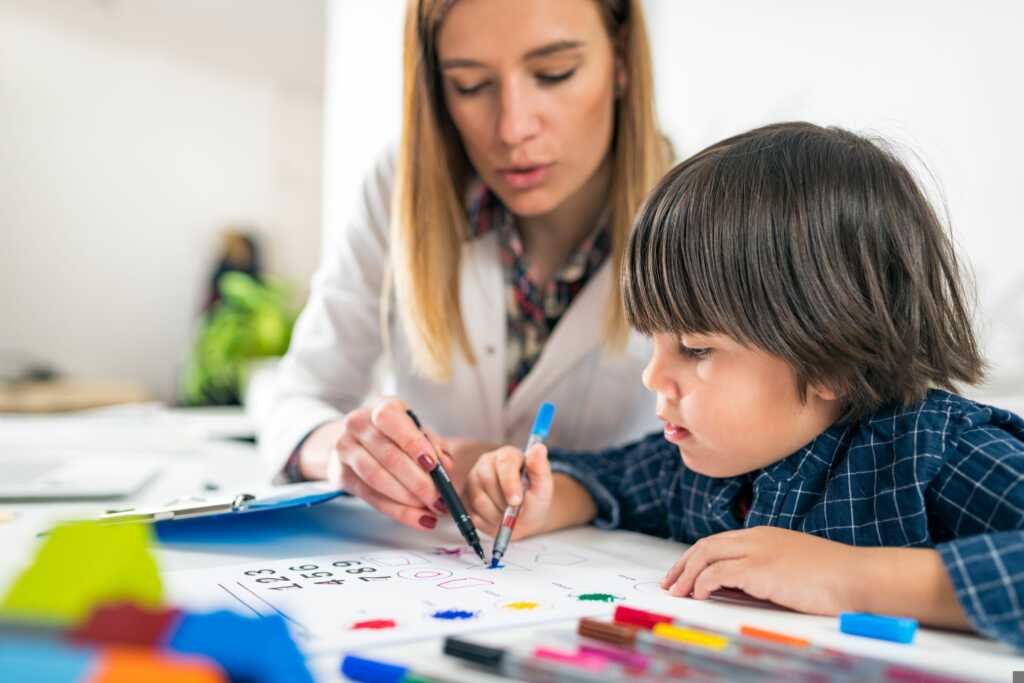Blog

Speech Therapy vs. Language Therapy: What’s the Difference?
As parents, we all eagerly await those precious first words from our children. When communication challenges arise, it’s natural to feel overwhelmed by the terminology and treatment options available. At our Brecksville pediatric therapy clinic, we frequently meet with families who are confused about the difference between speech therapy and language therapy. Here, we want to clear up some of the confusion and help you better understand your child’s unique communication needs.
The Foundation: Understanding Communication
Before diving into the specifics, it’s important to understand that communication involves multiple interconnected systems working together. Think of it like an orchestra – each instrument (or skill) must function properly and harmoniously with others to create beautiful music. When one area struggles, it can impact the entire performance.
Communication encompasses both speech and language, but these are distinctly different skills that serve unique purposes in helping your child connect with the world around them.
What is Speech Therapy?
Speech therapy focuses on the mechanical aspects of producing sounds and words. It addresses the physical process of how we create speech sounds using our mouth, tongue, lips, vocal cords, and breathing. Speech therapists work on what we call the “hardware” of communication.
Key Areas Addressed in Speech Therapy:
Articulation and Phonology
This involves helping children produce speech sounds correctly. For example, if your 5-year-old says “wabbit” instead of “rabbit” or struggles with the “th” sound in “think,” a speech therapist would work on positioning the tongue and lips correctly to produce these sounds clearly.
Fluency
Speech therapists address stuttering and other fluency disorders, helping children develop smooth, flowing speech patterns. They teach techniques to manage repetitions, prolongations, or blocks in speech.
Voice Disorders
When children have issues with vocal quality, pitch, or volume – perhaps speaking too quietly, with a hoarse voice, or in a monotone – speech therapy can help improve vocal production and health.
Oral-Motor Skills
This involves strengthening and coordinating the muscles used for speech, including exercises for the tongue, lips, jaw, and cheeks. Children with oral-motor difficulties might drool excessively, have trouble chewing certain textures, or struggle with precise tongue movements needed for clear speech.

What is Language Therapy?
Language therapy addresses the “software” of communication – the rules, meanings, and social aspects of how we use words and sentences to share ideas and connect with others. It’s about understanding and expressing meaning effectively.
Key Areas Addressed in Language Therapy:
Receptive Language
This is your child’s ability to understand what others are saying. It includes following directions, understanding questions, and comprehending stories or conversations. A child with receptive language challenges might struggle to follow multi-step instructions or seem confused during conversations.
Expressive Language
This involves how your child puts thoughts and ideas into words. It includes vocabulary development, sentence structure, and the ability to tell stories or explain events. Children with expressive language difficulties might use short, simple sentences, have trouble finding the right words, or struggle to organize their thoughts when speaking.
Pragmatic Language (Social Communication)
This encompasses the social rules of communication – taking turns in conversation, using appropriate volume and tone, understanding nonverbal cues, and adjusting communication style based on the listener and situation.
Semantic Language
This involves understanding word meanings, relationships between words, and concepts. It includes vocabulary development and understanding how words relate to each other and to real-world concepts.
Syntax and Grammar
This addresses sentence structure, word order, and grammatical rules that help us create meaningful sentences.
The Overlap: Why Many Children Need Both
In practice, many children benefit from both speech and language therapy because these skills are interconnected. A child who can’t produce certain sounds clearly (a speech issue) might avoid using words with those sounds, which can limit their vocabulary development (a language issue). Conversely, a child with language difficulties might become frustrated and speak less clearly due to the effort required to formulate their thoughts.
At Therapy and Wellness Connection, our Brecksville speech therapy team takes a holistic approach, recognizing that communication is complex and multifaceted. Our speech-language pathologists are trained to address both areas and often incorporate elements of both speech and language therapy into treatment sessions.
How We Determine What Your Child Needs
When you bring your child to our clinic, our comprehensive evaluation process helps us identify specific areas of need. We assess:
- Speech sound production and clarity
- Language comprehension and expression
- Vocabulary knowledge and use
- Sentence structure and grammar
- Social communication skills
- Oral-motor function
- Voice quality and fluency
Based on these findings, we develop an individualized treatment plan that may focus primarily on speech, language, or both areas simultaneously.
The Integrated Approach: Beyond Speech and Language
What sets our Brecksville, OH speech therapy team apart is our understanding that communication doesn’t exist in isolation. We offer a comprehensive range of services including occupational therapy, ABA therapy, homeschooling support, and vocational training because we recognize that children’s needs are interconnected.
For example, a child receiving speech therapy might also benefit from occupational therapy to address fine motor skills that impact their ability to use communication devices or write. Or a child with autism spectrum disorder might receive both language therapy and ABA services to support communication development within a behavioral framework.
Supporting Your Child at Home
Regardless of whether your child is receiving speech therapy, language therapy, or both, there are many ways you can support their communication development at home:
For Speech Development:
- Practice target sounds during daily activities
- Use mirrors during practice time
- Celebrate attempts and progress, not just perfection
- Make practice fun with games and songs
For Language Development:
- Read together daily and discuss stories
- Expand on your child’s utterances (“Yes, big dog” becomes “Yes, that’s a big, brown dog”)
- Give your child time to process and respond
- Use visual supports like pictures or gestures to support understanding
For Both Areas:
- Create communication opportunities throughout the day
- Follow your child’s interests to maintain engagement
- Use positive reinforcement to encourage communication attempts
- Be patient and give your child time to communicate
When to Seek Professional Help
Trust your instincts as a parent. If you have concerns about your child’s communication development, it’s always better to seek an evaluation sooner rather than later. Early intervention can make a significant difference in outcomes.
Consider seeking help if your child:
- Is difficult for unfamiliar people to understand
- Uses fewer words than peers their age
- Struggles to follow simple directions
- Rarely initiates conversations
- Shows signs of frustration when trying to communicate
- Has regressed in communication skills
- Avoids social interactions due to communication difficulties
Your Partner in Communication Development
At Therapy & Wellness Connection, we understand that every child is unique, and we’re committed to providing personalized care that addresses your child’s specific needs. Whether your child needs support with the mechanics of speech production, the complexities of language development, or both, our experienced team is here to guide you and your child on this journey.
Communication is one of the most important skills your child will develop, impacting their academic success, social relationships, and overall quality of life. By understanding the difference between speech and language therapy, you’re better equipped to advocate for your child’s needs and support their communication development.
Remember, seeking help for communication challenges is a sign of strength, not weakness. Every child deserves the opportunity to express themselves clearly and connect meaningfully with others. We’re here to help make that happen.
Therapy & Wellness Connection – your connection to a life without limitations – provides speech therapy to children in Akron, Cleveland, Brecksville-Broadview Heights and surrounding communities. We also offer summer camp, day programs, education services, vocational counseling and more. Call us at (330) 748-4807 or send us an email.
Additional Resources:
What is Speech? What is Language? ASHA
More Blog Entries:
